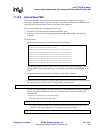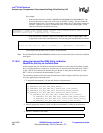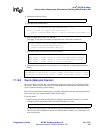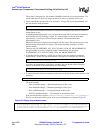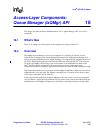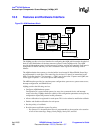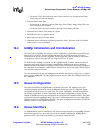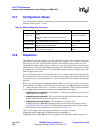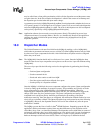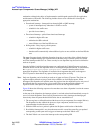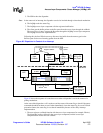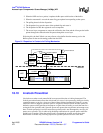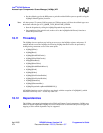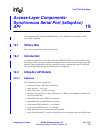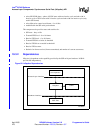
Intel
®
IXP400 Software
Access-Layer Components: Queue Manager (IxQMgr) API
Programmer’s Guide IXP400 Software Version 2.0 April 2005
Document Number: 252539, Revision: 007 269
may be called from a client polling mechanism, which calls the dispatcher to read the queues status
at regular intervals. In the first example, the dispatcher is called in the context of an interrupt and
the dispatcher gets invoked when the queue status change.
A parameter passed to the ixQMgrDispatcherLoopRun() function determines whether the lower set
of 32 queues, queues 0-31 or the upper set of 32 queues, queue 32-63 are serviced by the dispatcher
each time ixQMgrDispatcherLoopRun() is called. The order in which queues are serviced depends
on the priority specified by calling ixQMgrQDispatchPrioritySet().
Note: Application software does not need to access the queues directly. The underlying access-layer
component software (for example, EthAcc, HssAcc, etc.) handles this. However, the application
software does need to initialize the queue manager software using ixQmgrInit and set up the
dispatcher operation.
18.9 Dispatcher Modes
The Codelet/Customer code must first initialize the IxQMgr by making a call to ixQMgrInit(),
which takes no parameters and returns success or failure. No other IxQMgr functions may be called
by other access-layer components before this. After initialization, the queues must be configured
before they can be used.
Note: The ixQMgrInit() function should only be called once for a system. Once the IxQMgr has been
started all other access-layer components can register to use the services it provides without calling
ixQMgrInit().
The access-layer provides the following services for the application by performing the following
functions:
— Perform Queue configuration
— Set the watermark levels
— Reads and writes entries to and from AQM
— Provides register-notification callbacks for a queue
— Set the priority of a dispatcher callback
Once the IxQMgr is initialized, the access component configures the queues. Queue configuration
is done by setting up the attributes for respective queues. These attributes are typically set in the
access components by using ixQMgrQConfig( ) and ixQMgrWatermarkSet( ) functions.
Depending upon whether the queue is half full, nearly full, etc., the watermark level triggers the
change of the status flag for a particular queue. The queue configuration and setting of the
watermark levels and queue priority should be performed prior to enabling of the queue
notification status flag. Once the queues are configured, the notification callback needs to be set or
else it will go to a dummy callback. The Queue dispatcher loop can be started at any time following
a ixQMgrInit(). However, the dispatcher function will service the callback only once the queue
notification is enabled.
The IxQMgr governs the flow of traffic in Intel
®
IXP400 Software. Depending upon the OS, the
application, and the performance required, there are three different ways the dispatcher can be
called: Busy loop, event-, or timer-based interrupt. The dispatcher can be called either in context of
an interrupt or through a busy loop (which might run as a low-priority task). In case of an interrupt-
driven mechanism, the interrupt can be triggered either by a timer or upon generation of QM
hardware interrupts (which are event-driven). There is no single way to determine the best



